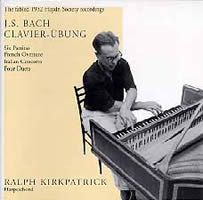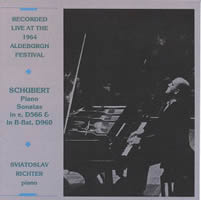Dear La Folia 10.
|
Russell Lichter [May 2003.] Dear La Folia, Spring in Black Point, hordes of male mosquitoes unable to find mates or draw blood, white and red roses wild with secret joy, hummingbirds guzzling sugar, squirrels scolding from telephone wires, and me with that faraway look in my eyes, contemplating the late-day sun. Now more than ever seems it rich to live.
W.A. Grieve-Smith’s several reviews entitled “New Goldbergs and Old Gouldbergs” are meat for my potatoes. I am Black Point’s foremost collector of Bach’s Aria mit verschiedenen Veränderungen. Of the several CDs G-S reviewed, Céline Frisch’s recording seemed by far the most intriguing. I got sidetracked, as sometimes happens. Ms. Frisch will have to wait a while. In searching for her recording, I came across a four-CD set of the Clavierübung I, II, IV performed by Ralph Kirkpatrick (Music & Arts 4976). This includes, in addition to the Goldbergs, the six Partitas, four Duettos (which I love), French Overture and the Italian Concerto. What made this a must-buy is Mark C. Dirksen’s glowing review on Amazon. His father, Wayne, was the recording engineer for these 1952 sessions. Kirkpatrick played a 1907 Dolmetsch harpsichord that employed wooden jacks and leather plectra, had one four-foot register, two eight-foot, and one 16-foot. It took some telephone work to find a copy. The set is OOP (out of print) and not for the first time. I ended up contacting Music & Arts in Kensington. Wonderful! They had a few copies left. Let’s hope they reissue this classic. It does happen. Writing about Céline Frisch’s performance, Mr. Grieve-Smith comments, “We take leave of the museum and move into an elegant 18th-century salon where music is a refined entertainment.” I cannot say where Kirkpatrick’s early recording falls within this milieu. For me, the playing is neither dry nor academic. It would probably be at home in any refined 18th-century salon. The performances are rich in authority and experience. Kirkpatrick, a teacher and scholar, radiates an inner delight. What is singularly appealing about this set, from an audiophile’s standpoint, is the recording of an excellent instrument itself no less excellent. This is the best harpsichord sound I’ve ever heard on disc. Kirkpatrick wrote in the introduction to his Schirmer edition of the Goldberg Variations: “The first variation stands like a festive gateway leading to the inner world exposed in the following three variations. These, like so many of the canons and the Aria, have an unearthly pure sweetness and a lyricism in every phrase that makes one long to dissolve one’s fingers, the instrument, and one’s whole self into three or four singing voices . But for all their lyricism and tragic passion and exuberance, the Aria and the Variations seem of a divine substance entirely refined and purified of anything personal or ignoble, so that in playing them one seems only the unworthy mouthpiece of a higher voice.” I wrote to Mr. Dirksen thanking him for his review and in the course of my letter asked, “Are the Goldberg Variations not the most perfect composition ever?” The question was neither flippant nor hyperbolic. Listening to the Goldbergs leaves me with a sense of having seen all of life, all wisdom and spiritual understanding, the whole panoply. I emerge changed, carrying a golden trove in my heart, more than ever convinced that when the bloated bank accounts in the Seychelles, the mansions, factories, farms and history books have crumbled to dust, we will be remembered for our art.
I’ve mentioned in an earlier letter Bruno Monsaingeon’s film Richter, the Enigma. Among the real delights of this VHS tape are some excerpts of Richter’s performances at the Aldeburgh Festival at Snape Maltings,* including a Mozart piece for two pianos, which Richter performs with Benjamin Britten. Some of these performances were recorded for publication and one such, Richter Live from Aldeburgh 1964 (Music & Arts 642), contains two Schubert sonatas, the E-minor (D. 566) and the B-flat (D. 960). Alas, this is another difficult-to-find disc. My wanted posting on Amazon took some months to pay off but finally did, as a sealed copy. The sound quality is nothing to write home about, though far superior to some of the dreadful recordings from the former Eastern-Bloc countries. The performances, however, are another matter. And it is Richter’s playing of the great posthumous B-flat sonata that justifies the trouble of finding this disc. Here is the maestro in an intensely contemplative mood, performing at a favored venue to which he returned numerous times. The first movement (Molto moderato) alone runs over 25 minutes. I don’t believe I’ve ever encountered a version in which it’s played this slowly. What continues to amaze me after numerous auditions is how absolutely perfect that tempo is, how utterly appropriate and revealing of the music’s soul. From here we enter the almost unbearably tragic world of the Andante sostenuto, sometimes held to be Schubert’s greatest single composition for piano. The last two movements of this sonata, of so different a character, flow seamlessly from what precedes. There is no sense of discontinuity in moving from one emotional extreme to another. I cannot help wondering if this was not an affirmation of sorts, Schubert assuring us that despite sadness and tragedy, there’s an underlying light and joy. We read into works of art what we want, of course. This sort of emotional shift, from the profound and tragic to the light and joyous, does not always work. Mozart’s G-minor String Quintet springs to mind. My encomiums must be wearing thin. Somewhere, either in Monsaingeon’s film or his book, I recall Richter saying that it’s just a matter of playing the notes as the composer wrote them, a characteristically modest statement from a man who cared nothing for praise or fame or money and who really seemed to care for only two things, freedom and music. Sleep tight, don’t let the bedbugs bite. * From the Snape Maltings Web site: “Snape Maltings is a uniquely attractive collection of 19th Century buildings on the River Alde in Suffolk. It is an Area of Outstanding Natural Beauty (AONB), and is a designated conservation area, the river and marshes surrounding it are a haven for wildlife. The river is tidal as far as Snape, 20 miles from the river mouth, yet only 5 miles from the sea as the crow flies.” [More Dear La Folia, Russell Lichter]
[Previous Article:
From the Archives: Casals, Furtwängler, and More]
[Next Article:
Unfamiliar Masters]
|

